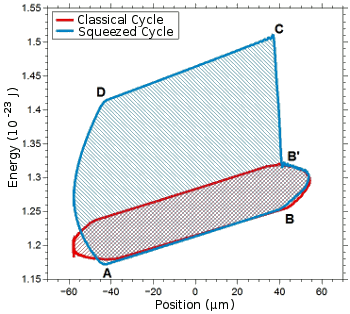Single Ion Engine
February 26, 2014
Modern
technology has enabled many things that were formerly considered impossible. Technology has given us our present ability to isolate and image single
atoms, and to use these in useful devices and some critical
experiments. The development of the
scanning tunneling microscope and the
atomic force microscope in the 1980s has revolutionized our understanding of materials at the atomic level.

Figures 5 and 6 from US Patent No. 4,343,993, "Scanning Tunneling Microscope," by Gerd Binnig and Heinrich Rohrer, August 10, 1982.
Bennig and Rohrer were awarded the 1986 Nobel Prize in Physics for the invention of the scanning tunneling microscope.
Calvin Quate and Christoph Gerber invented a variation of this instrument, the atomic force microscope, in 1986.
(Via Google Patents.)
I wrote about imaging atoms in a
previous article (Imaging Atoms, September 26, 2012). Atoms of tungsten and uranium were the first to be imaged. These were easy targets for electron microscopy, since they're relatively large and packed full of electrons. Uranium atoms have a covalent radius of 196 picometers (pm), while that of hydrogen atoms is just 31 pm.
Atomic imaging has advanced to the state that even carbon (covalent radius, 69-76 pm, dependent on the allotrope) is easily imaged. This imaging has discerned the difference in bond length that exists from the center of a patch of graphene to its edge.[1-3]
As I wrote in a previous article (A Single-Atom Transistor, February 24, 2012), you can even make a transistor from a single atom. Going to even smaller particles, you can make a fundamentally accurate ammeter by counting electrons as they pass a point in your electrical circuit.[4-5] That's because an ampere is defined as the movement of 6.241 x 1018 electrons past a point in one second; that is, a coulomb per second.[6]
What else can be accomplished with single atoms? German physicists at the Universität Mainz (Mainz, Germany) and the University of Erlangen-Nürnberg (Erlangen, Germany) have proposed a single atom, quantum Otto cycle, engine.[7-10] Since quantum mechanics is involved, the limits imposed by classical thermodynamics can be violated. Their Monte Carlo simulations of a particular geometry of a type of ion trap called a linear Paul trap show that the Carnot limit of efficiency can be exceeded by a factor of two.[7-8]
Thermodynamic efficiency is expressed as the useful work realized as a fraction of the input heat energy. As in all engines, work is only possible if there's a difference in temperature between two heat reservoirs. In the quantum realm, it's possible to have "squeezed" states in which noise is concentrated in one parameter while being diminished in another. It's possible, therefore, to form a system in which an engine can exceed the classical limit of efficiency, the Carnot limit.[8]

In the single ion engine, the ion is contained in a linear Paul trap formed by the divergent bars.
The "squeezed" states are realized by electrical fields.
(University of Mainz image.)
Classical thermodynamics is based on the idea of an equilibrium system, but an oscillator might have more phase noise than amplitude noise, and "squeezing" the system can distribute the noise in a selected way. In the single ion engine, there's one laser that acts as a high temperature reservoir that adds energy to the oscillating ion, while another laser is the low temperature reservoir that removes energy. When the high temperature reservoir is squeezed, the oscillating ion works more efficiently (see figure).[8]

The Otto cycle of a single ion heat engine.
The area inside the curve is the work done by the engine, and the squeezed state engine produces much more work.
(University of Mainz image, modified by English translation.)
The research group first proposed the idea of this engine about a year ago.[10] A calcium-40 ion was selected for the engine because of its particular electron energy levels. Says Johannes Rossnagel of the University of Mainz,
"Exceeding the Carnot limit for a standard heat engine thus does not violate the second law of thermodynamics but instead demonstrates that the use of specially prepared, non-thermal heat reservoirs also makes it possible to further improve efficiency."
Presently, this nanoengine is just a paper concept, but a prototype is being constructed at the University of Mainz.[9]
References:
- Jason Palmer, "Atomic bond types discernible in single-molecule images," BBC News, September 13, 2012.
- Ruben Perez, "Discriminating Chemical Bonds," Science, vol. 337, no. 6100 (September 14, 2012), pp. 1305-1306.
- L. Gross, F. Mohn, N. Moll, B. Schuler, A. Criado, E. Guitian, D. Pena, A. Gourdon and G. Meyer, "Bond-Order Discrimination by Atomic Force Microscopy," Science, vol. 337, no. 6100 (September 14, 2012), pp. 1326-1329.
- S.P. Giblin, M. Kataoka, J.D. Fletcher, P. See, T.J.B.M. Janssen, J.P. Griffiths, G.A.C. Jones, I. Farrer & D.A. Ritchie, "Single electron pumps: towards a quantum representation of the ampere," arXiv Preprint Server, March 13, 2012.
- S.P. Giblin, M. Kataoka, J.D. Fletcher, P. See, T.J.B.M. Janssen, J.P. Griffiths, G.A.C. Jones, I. Farrer & D.A. Ritchie, "Towards a quantum representation of the ampere using single electron pumps," Nature Communications. vol. 3, article no. 930 (July 3, 2012), doi:10.1038/ncomms1935.
- A Fundamental Ampere, This Blog, July 20, 2012.
- J. Rossnagel, O. Abah, F. Schmidt-Kaler, K. Singer and E. Lutz, "Nanoscale Heat Engine Beyond the Carnot Limit," Physical Review Letters, vol. 112, no. 3 (January 24, 2014), Document No. 030602 [5 pages].
- Michael Schirber, "Synopsis: “Squeezed” Engine Could Break Thermodynamic Limits," APS Physics Web Site.
- Physicists at Mainz University build pilot prototype of a single ion heat engine, University of Mainz Press Release, February 3, 2013.
- O. Abah, J. Rossnagel, G. Jacob, S. Deffner, F. Schmidt-Kaler, K. Singer and E. Lutz, "Single-Ion Heat Engine at Maximum Power," Physical Review Letters, vol. 109, no. 20 (November 16, 2012), Document No. 203006 [6 pages].
Permanent Link to this article
Linked Keywords: Technology; atom; experiment; scanning tunneling microscope; atomic force microscope; Gerd Binnig; Heinrich Rohrer; Nobel Prize in Physics; Calvin Quate; Christoph Gerber; Google Patents; tungsten; uranium; electron microscope; atomic radius; electron; covalent radius; picometer; hydrogen; carbon; allotrope; bond length; graphene; transistor; elementary particle; ammeter; electrical circuit; ampere; second; coulomb; German; physicist; University of Mainz; Universität Mainz (Mainz, Germany); University of Erlangen-Nuremberg; University of Erlangen-Nürnberg (Erlangen, Germany); quantum mechanics; Otto cycle; reciprocating engine; classical thermodynamics; Monte Carlo simulation; ion trap; quadrupole ion trap; linear Paul trap; Carnot cycle; Carnot limit; energy conversion efficiency; thermal efficiency; thermodynamic efficiency; thermodynamic work; heat energy; thermal reservoir; heat reservoir; electric field; electrical field; thermodynamic equilibrium; equilibrium system; harmonic oscillator; phase noise; amplitude noise; laser; research; calcium-40; energy level; Johannes Rossnagel; prototype; Gerd Binnig and Heinrich Rohrer, US Patent No. 4,343,993, "Scanning Tunneling Microscope," August 10, 1982.
 RSS Feed
RSS Feed
Google Search
Latest Books by Dev Gualtieri
Previews Available
at Tikalon Press

STEM-themed novel for middle-school students



Mathematics-themed novel for middle-school students



Complete texts of LGM, Mother Wode, and The Alchemists of Mars

Other Books

Blog Article Directory on a Single Page
Recent Articles
- Green Ammonia, July 22, 2024
- Cold Brew Coffee, July 15, 2024
- US Independence Day, July 4, 2024
- Copper and Green Energy, July 1, 2024
- Baseball Mud, June 24, 2024
- Wiedemann-Franz Law, June 17, 2024
- A.I., Wine, and Beer, June 10, 2024
- Bergmann's rule, June 3, 2024
- 60 Hertz Standard, May 27, 2024
- Droplets, May 20, 2024
- Levitation, May 13, 2024
- 100 Years of IBM, May 6, 2024
- Cicada Apocalypse, April 29, 2024
- Critical Materials, April 22, 2024
- Eclipse 2024, April 15, 2024
- Reverse Sprinkler, April 8, 2024
- T Coronae Borealis, April 1, 2024
- Coffee and Tea, March 25, 2024
- Arno Penzias (1933-2024), March 18, 2024
- Wave-Particle Duality, March 11, 2024
- Offshore Wind, March 4, 2024
- High Entropy Ceramics, February 26, 2024
- Methane Emissions, February 19, 2024
- Thales, Heron, and Experimental Mathematics, February 12, 2024
- Mica, February 5, 2024
- Disk Packing, January 29, 2024
- Is eπ > πe?, January 22, 2024
- Brownian Motion Energy Harvesting, January 15, 2024
- Coin Flip, January 8, 2024

Deep Archive
Deep Archive 2006-2008
